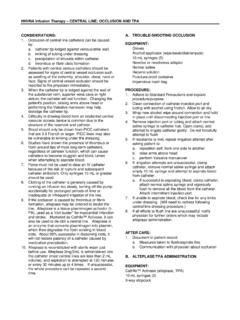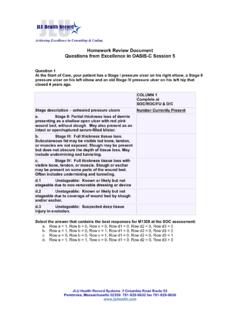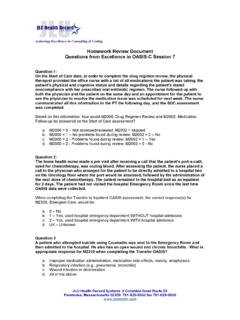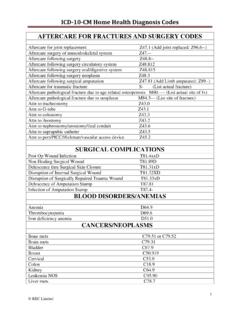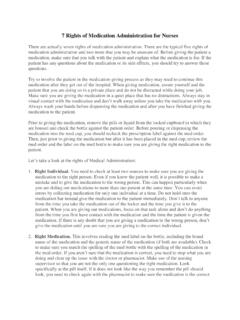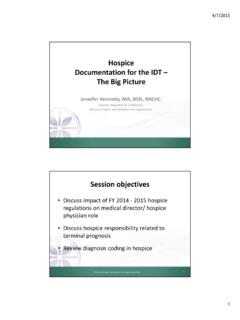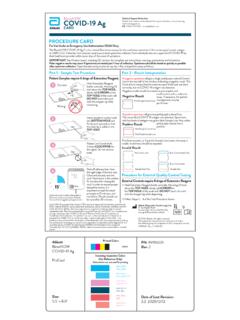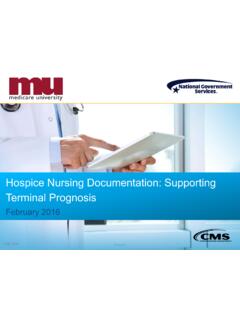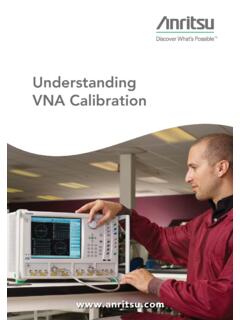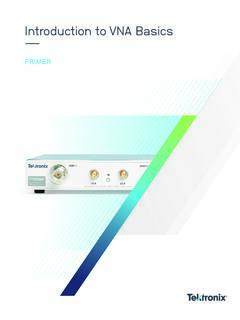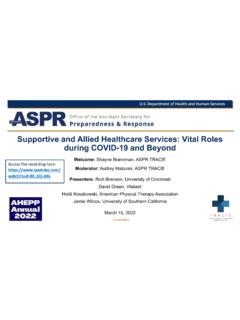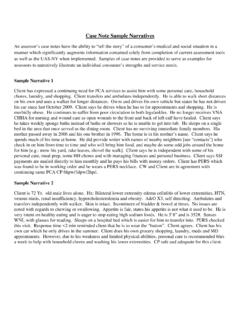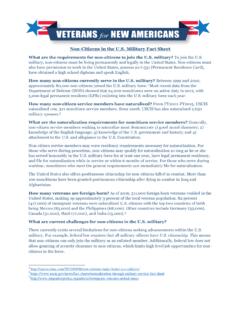Transcription of BRADEN SCORE INTERVENTION GUIDE - hhvna.com
1 BRADEN SCORE INTERVENTION GUIDE 19-23 No Risk Continue to assess per agency timeline. 15-18 At Risk Identify areas of risk. Select at least one INTERVENTION within those risk categories and implement. 13-14 Moderate Risk Select at least one INTERVENTION from each risk category and implement. Refer to WOCN. 10-12 High Risk Select all appropriate interventions including at least one bold INTERVENTION .
2 Refer to WOCN. 9 or below Very High Risk All of the above + pressure reduction support surface is required. Refer to WOCN. Clinician should always use good clinical judgment and implement all interventions and referrals as dictated by patient need. Sensory Perception Moisture Activity Mobility Nutrition Friction and Shear 1. Reduce pressure on ankles and feet with foam or waffle boots or by elevating calf so that heels are not touching bed or reclining chair surface. 2. Inspect feet and ankles daily. 3. Instruct to avoid hot water and heating pads. 4. Educate patients and caregivers about causes and risk factors for pressure ulcer development.
3 1. Establish a bowel and bladder program for incontinent patients. 2. Cleanse gently after each incontinent episode. 3. Encourage appropriate hydration. 4. Instruct to apply skin barrier ointments to protect skin from moisture and heal denuded skin. 5. Instruct to avoid diapers to contain effluent except when patient is out of bed to walk or in a chair. 6. Consult with WOCN. 7. Identify fungal infections, notify MD, and treat quickly (nystatin powder or antifungal cream/ per MD). 8. Order Low air loss bed to dry constantly moist skin. 1. Position chair-bound patients when seated with attention to anatomy, postural alignment, distribution of weight and support of feet.
4 2. Instruct to reposition chair-bound individuals every hour if they cannot perform pressure relief exercises every 15 minutes. 3. Encourage increased activity. Even slight changes in position can make a positive difference. 4. Order specialty bed or overlay to reduce pressure. Continue turning but increase frequency and use foam or waffle heel protectors. 1. Instruct to turn and reposition at least every 2-4 hours on a pressure reducing mattress or 2 hours while in bed or chair. 2. Inspect bony prominences every day/visit. 3. Place at risk individuals on pressure reduction surface. 4. Refer to Physical and/or Occupational Therapist.
5 1. Evaluate nutritional status of patients at risk by obtaining a recent diet history. 2. Encourage liquid nutritional supplements as ordered. 3. Instruct to increase protein intake. 4. Instruct to supplement diet with multivitamin. 5. Consult with Nutritionist. 6. Monitor weights, intake/output, count calories if indicated. 7. Assess laboratory parameters to determine nutritional status; may include obtaining albumin, pre-albumin, transferrin, total lymphocyte count blood levels. Low SCORE correlates to decreased wound healing and increased pressure ulcers. 1. Use turning sheets or pads to reposition. Trapeze bar to encourage patient to assist.
6 2. Elevate head of bed no more than 30 degrees. 3. Protect vulnerable areas from friction by applying transparent film, socks, or elbow protectors. 4. Instruct to avoid excessive rubbing when cleansing and drying skin. 5. Instruct to avoid soap. Use moisturizer on dry skin and bony prominences daily. 6. Instruct not to massage reddened bony prominences. 7. Avoid foam rings, donuts, and sheepskin. 8. Lower head of bed 1 hour after meals or tube feeding. If this is not possible because of patient s medical condition, assess sacral region more frequently. Wound, Ostomy, and Continence Nurses Society. (2003). Guideline for Prevention and Management of Pressure Ulcers.
7 Glenview, IL: Author. 10/12/09 Stotts NA: Nutritional Assessment and Support. In Bryant RA, Nix DP, editors: Acute and Chronic Wounds Current Management Concepts, ed 3, St Louis MI, 2007, Mosby. Catania K et al: PUPPI: The Pressure Ulcer Prevention Protocol Interventions, AJN, American Journal of Nursing 107:4, 2007. BRADEN PRESSURE ULCER RISK ASSESSMENT Home Health VNA Standard of Care: BRADEN Scale must be completed at Start of Care, Resumption of Care, Recertification, and change in patient condition. SENSORY PERCEPTION: Ability to respond meaningfully to pressure-related discomfort. 1. Completely Limited: Unresponsive (does not moan, flinch or grasp) to painful stimuli due to diminished level of consciousness or sedation.
8 OR limited ability to feel pain over most of body surface. 2. Very Limited: Responds only to painful stimuli. Cannot communicate discomfort except by moaning or restlessness. OR has a sensory impairment which limits the ability to feel pain or discomfort over of body. 3. Slightly Limited: Responds to verbal commands but cannot always communicate discomfort or need to be turned. OR has some sensory impairment which limits ability to feel pain or discomfort in 1 or 2 extremities. 4. No Impairment: Responds to verbal commands, has no sensory deficit which would limit ability to feel or voice pain or discomfort. : MOISTURE: Degree to which skin is exposed to moisture 1.
9 Constantly Moist: Skin is kept moist almost constantly by perspiration, urine, etc. Dampness is detected every time patient is moved or turned. 2. Very Moist: Skin is often, but not always, moist. Linen must be changed at least once a shift. 2. Occasionally Moist: Skin is occasionally moist, requiring an extra linen change approximately once a day. 3. Rarely Moist: Skin is usually dry, linen only requires changing at routine intervals. ACTIVITY: Degree to which skin is exposed to moisture 1. Bedfast: Confined to bed. 2. Chairfast: Ability to walk severely limited or non-existent. Cannot bear own weight and/or must be assisted into chair or wheelchair.
10 3. Walks Occasionally: Walks occasionally during the day, but for very short distances, with or without assistance. Spends majority of each shift in bed or chair. 4. Walks Frequently: Walks outside the room at least twice a day and inside room at least once every 2 hours during waking hours. MOBILITY: Ability to change and control body position 1. Completely Immobile: Does not make even slight changes in body or extremity position without assistance. 2. Very Limited: Makes occasional slight changes in body or extremity position but unable to make frequent or significant changes independently. 3. Slightly Limited: Makes frequent though slight changes in body or extremity position independently.
